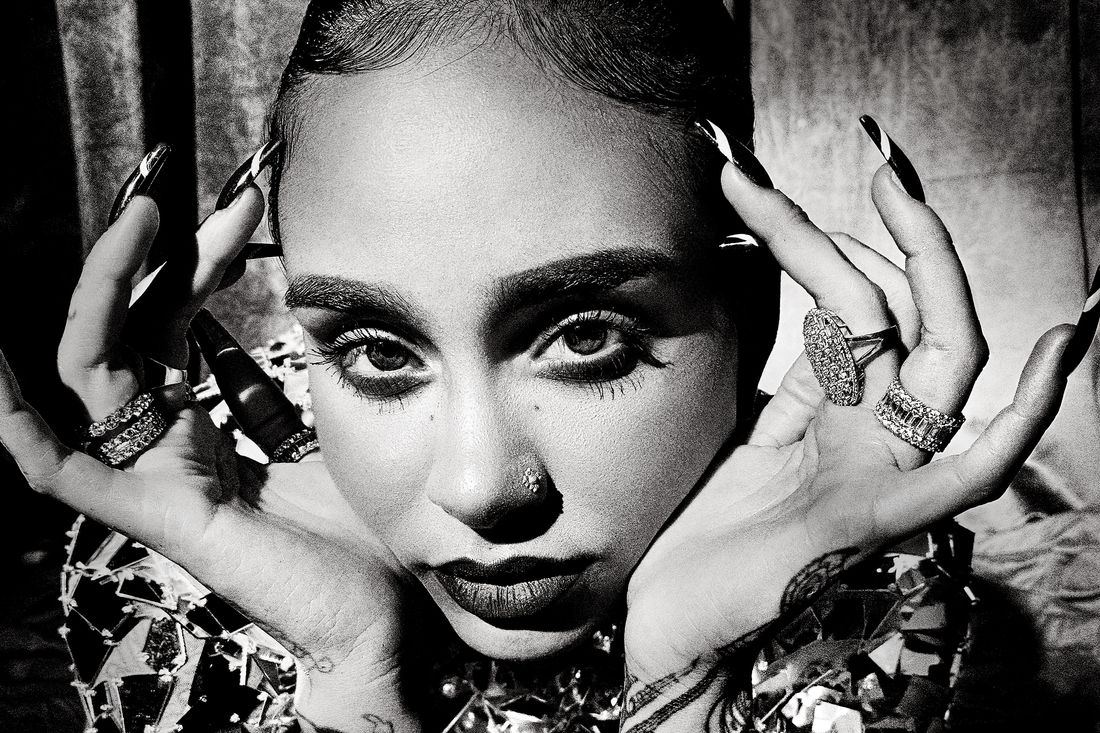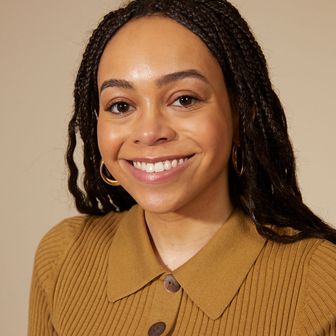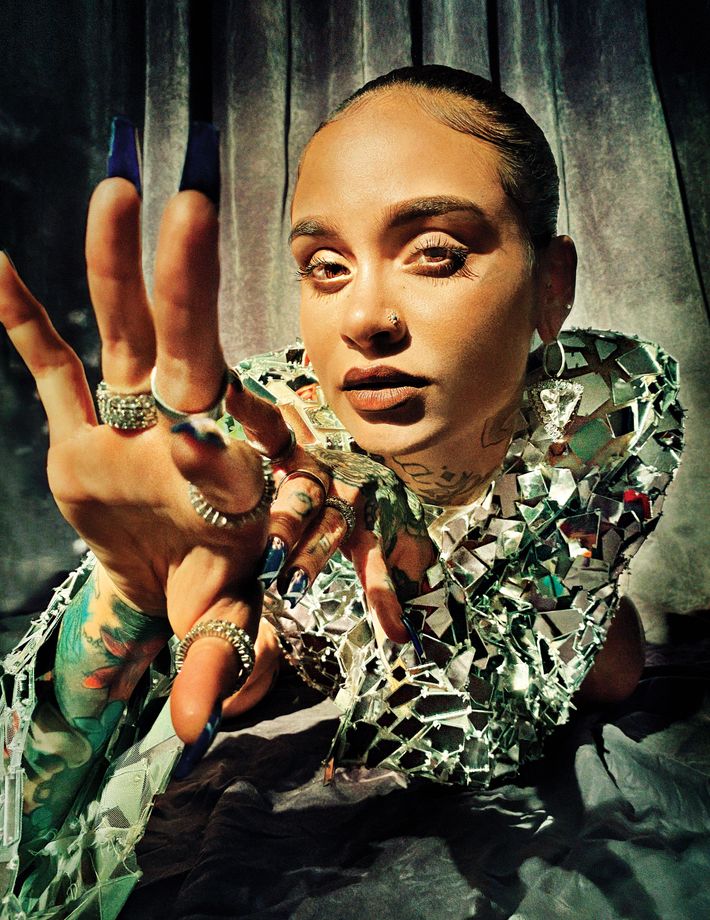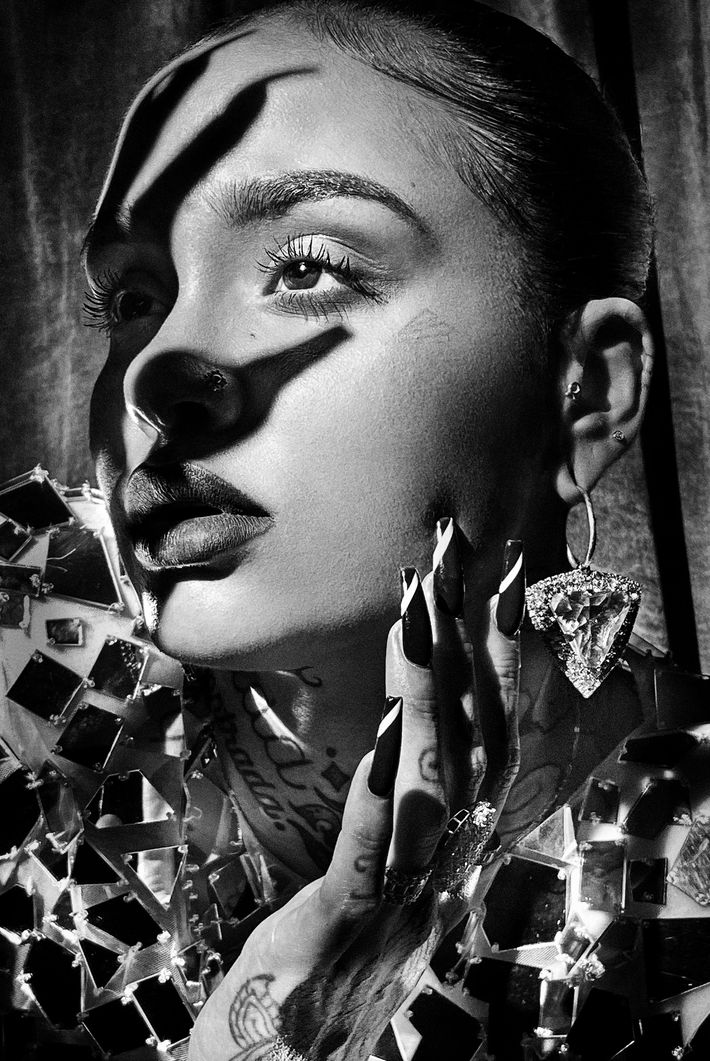
Editor’s note: Kehlani’s pronouns are now they/them.
Earlier this March, Kehlani was scheduled to meet with her record label. She was preparing to put out her second album — her first since having a baby and a return to her R&B roots. There was a plan to open on Justin Bieber’s Changes tour, along with a number of dreamy solo dates. Executives at Atlantic told her they believed in the album, which was supposed to be released on April 24, also her 25th birthday, but the coronavirus pandemic was making it impossible to chart a plan for its promotion. It would have to be postponed.
“I was casting actors and actresses. I was doing all kinds of shit,” she says of all the preproduction she’d completed by the time of the mid-March meeting. We’re speaking over a Zoom video call; Kehlani is sitting alone in a sunlit bedroom in her Los Angeles home. (Later on, she’ll be joined by her dog, a pint of ice cream, and a tequila drink with an orange slice peeking out.) Today happens to be the original release date. “They were like, ‘We just don’t think you should [release it],” she says. “And then I went in my room and made the ‘Toxic’ video on my laptop.” She posted it on YouTube at the end of March. “People fucked with it,” she adds.
When Kehlani’s label agreed to her request to release the album this month, the stipulation was that she had to do everything herself. “They’re like, ‘If all we’re doing is making the music and pressing the button, then you could do it,’ ” she summarizes. “And I was like, All right, challenge fucking accepted.” So now, Kehlani and her photographer, whom she is quarantined with, are planning and editing music videos, photo shoots, and the album cover. (She also lives with her daughter, two younger siblings, a close friend, and her assistant.) Her garage has been converted into a twofer studio, one side for music, the other for visuals.
Kehlani has been a professional musician since she was 13. A series of mixtapes — full of relatable overshares about having your heart built and broken — and one haphazardly produced, but successful, debut album have already made her an industry stalwart. Her music is R&B in its purest form: songs about the way love undoes you, about floating on the pure adrenaline of a crush, about longing for someone whose heart can’t be trusted. It’s no coincidence that when white artists like Bieber and Charlie Puth want to lean into an R&B sound, they call Kehlani for the assist. The new album, It Was Good Until It Wasn’t, is part of a genre revival in the midst of its fiercest debate.
It also feels like a transition record, a bridge from adolescence to adulthood. Throughout her career, Kehlani has been seen as the homegirl of R&B: sexy but tomboyish. In her old music, she played with both sides of the binary. On the new record, she’s outgrown it. She made it immediately after giving birth to her now-one-year-old daughter, Adeya. (She currently co-parents with her ex, Adeya’s father, Javaughn Young-White, younger brother of The Daily Show’s Jaboukie.) “People would always be like, Kehlani is adorable or, like, Kehlani is hella cool. But then I had a baby and it added this, like, womanly grown aspect to me,” she says. “So I guess I was like, Okay, I’m going to start shaking my ass and talking about it.” (She wanted Bieber on a track for her album, but he declined. “Because he’s a super-married guy now it didn’t really fit,” she tells me. “It might’ve been a little too nasty for the Biebs, but he’s supercool.”)
Kehlani’s self-directed music video for “Toxic,” filmed with only her MacBook’s camera, shows the singer’s sinewy figure sliding and twerking, rubbing her arms and her hips. “Don Julio made me a fool for you,” she croons, telling her onetime lover that she won’t reach out to him, even though her body’s every instinct is pushing her to. Kehlani insists it’s not about her last relationship, which ended publicly and painfully, with the Compton rapper YG earlier this year. It’s the type of headline-inducing personal drama that has made Kehlani blog-famous. She writes songs addressing it all openly. Her fans grow with her journey because she is transparent, sometimes to a fault. Or, as she says, “I fuck up publicly, and that makes people feel like I’m not an alien. I’m a human-ass person. I be fucking up in front of the entire world.”
The conversation about the state of R&B was reignited last November, when Lizzo, often considered a pop artist, won Album of the Year at the Soul Train Awards, beating soul singer Ari Lennox. (“It’s clear I’m not ‘cool’ enough,” Lennox tweeted after her loss. “Not trendy enough and I don’t care to be.”) This February, the rapper Young M.A went further, claiming that “we barely have R&B.” Indeed, in recent years, the genre’s superstars — like SWV, Boyz II Men, Ginuwine, Toni Braxton — and their musical descendants have mostly failed to arrest the charts like they did two decades ago; many contemporary black musicians shirk the label, preferring to be called “alternative R&B,” while others experiment more with genres that were once declared off limits by gatekeepers. Kehlani, by contrast, is part of a coterie of artists keeping R&B relevant today, along with newcomers like Summer Walker, Bryson Tiller, and Lennox. She has a song for every stage of a relationship: the getting under, the getting over, the watching the door waiting for her to arrive, the personal promise to stop texting him. Her music sounds new — not like a carbon copy of a Brandy song — but the influence is palpable.
She finds the genre’s current debate — what R&B is, what it was, and where it’s gone — boring. It may no longer sound like it did in the ’90s, but rappers (think, most recently, Drake) have expanded it beyond the desperate longing (or desperate lovemaking) of last century. “I just don’t think people know enough about music to make those types of accusations [that R&B no longer exists]. R&B is simple lyrics with great singing. Lots of harmonies and stacks and melodic production,” she says, like it’s easy. “I’m never gonna be able to make ’90s R&B music. I’m never going to be able to make early 2000s R&B music, because that’s not when I was making music. That’s not when I was experiencing things that shaped my lyrics and my sound.”
Kehlani was born in Oakland and raised by her aunt. Her mother struggled with drug addiction, and her father died when he was 24 and she was a toddler. A stint on America’s Got Talent connected her to Nick Cannon; he paid for studio time for her to make her first mixtape in 2014. On Cloud 19, you can hear the beginnings of a major talent: Her voice sounds higher and younger, but it’s brimming with emotion. On the bridge of Cloud 19’s “As I Am” she sings the chorus of a Mary J. Blige classic (“I Can Love You”) and pulls it off. A week after the release of her second mixtape in 2015, she signed to Atlantic Records.
Kehlani pivoted to pop with her 2017 debut, SweetSexySavage, an album full of rushed, half-finished ideas. It was completed in the midst of a personal mental-health crisis, brought on by rumors that she had cheated on her now ex-boyfriend, NBA player Kyrie Irving, in 2016. The relentless bullying online pushed her to attempt suicide. (Irving later acknowledged she had never been unfaithful.) “I started an album as one person and went through the most traumatic event in my life,” she says. Her label held fast to its deadline, leaving her to make an album from songs she barely recognized. “I didn’t connect with any of the music,” she says. “I was embarrassed of everything.”
The new record is a reset, closer to the Grammy-nominated mixtapes that made her famous. It Was Good Until It Wasn’t gives the rush of pure R&B, the “waiting for you to call me” R&B, the “only thing I care about is you” R&B: Brandy and Monica volleying hits in the ’90s, Alicia Keys’s early 2000s falling-in-love classics. It also finds her less moved by adolescent longing and more by the immediacy of adult desires. Her first mixtapes dealt with girlhood and growing up; It Was Good Until It Wasn’t is at peace with the way most conflicts or heartbreaks shake out. The title came from a conversation with a friend about her recent breakup. “That shit’s life, you know?” she says. “Shit is good and then it’s not.”
Despite being in the industry since she was a teenager, Kehlani has never had a career-defining hit, and it’s unlikely the new album will deliver one. “F&MU” is hot and danceable, and the collaboration with Canadian R&B star Tory Lanez, “Can I,” is a sexy earworm — though neither song seems especially suited to virality. Her biggest hits are the SEO-friendly gossip blogs that cast an outsize shadow on her music. Her three-month relationship with YG ended right after they’d put out a song together proclaiming their love. (Their duet was released the day before Valentine’s Day 2020; three days later she released a breakup song after footage surfaced of him cheating on her.) Minutes before one of our calls, Kehlani posted a series of tweets addressing a feud with a fellow Oakland native, the rapper Kamaiyah, who’d slammed her on Instagram Live over an unreleased mixtape and accused her of being colorist, among other things. “She put a green light on me and my family and basically told everyone in Oakland to kill us over a song,” Kehlani says. (Kamaiyah later responded, saying to Kehlani, “I apologize, I shouldn’t threaten you,” but added that “a green light means go like fight not shoot.“) A moment into our chat, she answered a phone call from a friend and nervously asked if her tweets — which had let the rapper know there was no bad blood — were all right, if she’d handled it well.
Kehlani and Kamaiyah had long teased a joint mixtape, due to come out before both of their albums dropped. Its production was fraught, and even basic decisions — how many songs it should have, what it should be called, what the visual aesthetic should be — were, according to Kehlani, met with resistance by Kamaiyah. In the end, she was tired of the back-and-forth, and the mixtape didn’t feel as essential as her album’s release. When she returned to our call, her mood was dismayed. “I tried to reach out to do good business about it and she was like, ‘If the whole project isn’t coming out, you can’t have [a single track from it],’” she says. “Even though I wrote it.” Yet again, she’d been swept up in drama she couldn’t control, tweeting clarifications about a feud she didn’t care about, instead of celebrating her album’s upcoming release. But why dispute a mischaracterization at all if she’s tired of getting caught up in drama? “How can I put this to rest and out of my body? Because I don’t want to carry [them],” Kehlani explains. “Even if you don’t ever want to fuck with me again, how can I ensure that you know it’s love on this side?” She fired off the Kamaiyah tweets to let the rapper know she wished her the best.
She is satisfied with the way she de-escalated an unexpected quarrel. A few years ago, she wouldn’t have been so levelheaded. “It took a lot of fucked-up shit to get here,” she says. The death of two friends in three months put a lot into perspective. The Philly rapper Chynna overdosed in April at 25; Minnesota rapper Lexii Alijai, whom Kehlani considered “like a little sister,” overdosed on New Year’s Day at only 21. There was a plan to have Alijai open for her on the post-Bieber headlining tour. “I just couldn’t believe it because [Alijai was] so young,” she says. “It was triggering and it was mind-blowing and it was sad and it was heartbreaking. I’m still trying to figure out how best to help assist in carrying on their legacies.”
Turning 25, too, was, more than a quarter-life milestone. It was a horizon she never thought she’d see. “I always had a weird thing with being 25 or older,” she says. “It’s a shock because I’m now older than my father got to be.” It’s part of what makes It Was Good Until It Wasn’t feel like the album on which she finally grew up. “I wanted to sound 25 on this one,” she says.
If you are in crisis, please call the National Suicide Prevention Lifeline at 1-800-273-TALK (8255), or contact the Crisis Text Line by texting HOME to 741741.
*A version of this article appears in the May 11, 2020, issue of New York Magazine. Subscribe Now!
Styling by: Scot Louie. Makeup and Hair by: Kehlani. Assistant by: Sierra Stevens.




